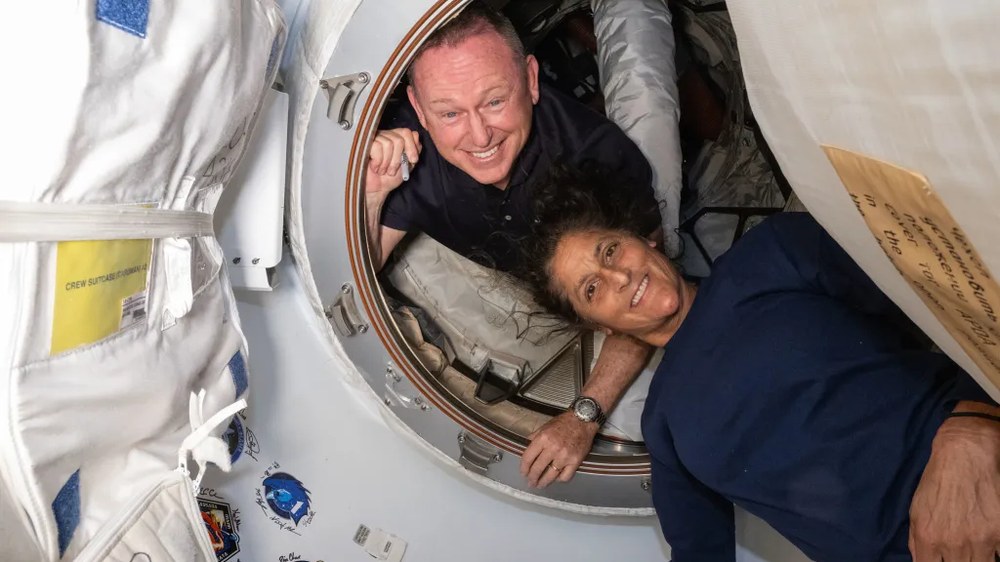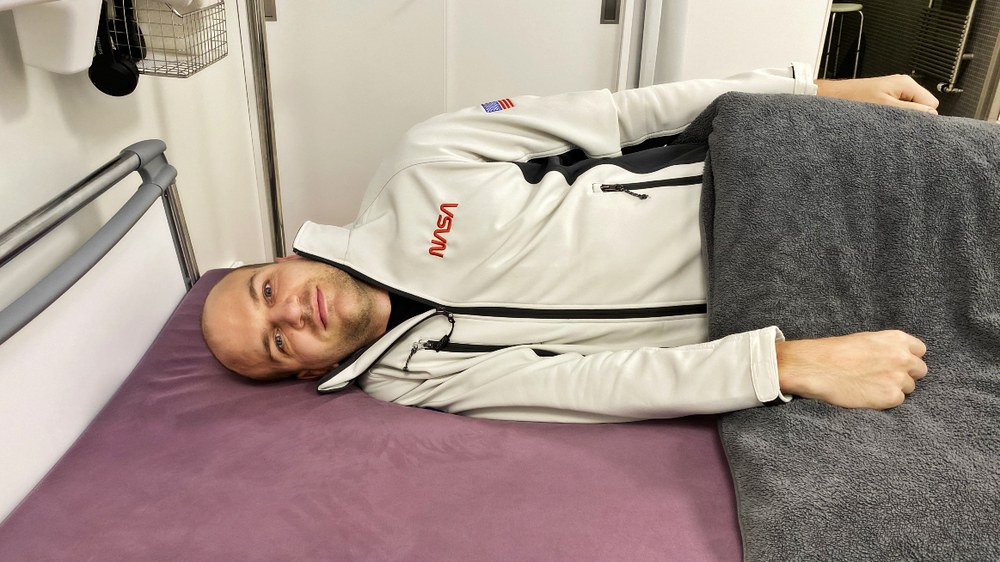400 kilometres apart and yet connected: my analogue mission with the crew on the ISS

NASA
In this blog about the DLR-NASA bed rest study 'Sensorimotor Countermeasures Study (SMC)', we report on the lives of the participants as well as the work of the larger team around them, and what it means to be part of such a major study.
Today, one of the participants who has been in bed for 18 days in a six-degree head-down position, shares his experience. This participant has a special connection to space exploration, as he closely follows the missions of two American astronauts, Barry Wilmore and Sunita Williams, who embarked on their journey to the International Space Station ISS at the very same time that he began his study. Their launch was delayed several times, and now their return to Earth has been postponed by eight months due to technical issues. Our participant, however, will not be in this position for nearly as long, as his 'return to Earth' is relatively more straightforward: at the end of November, after completing the head-down tilted bed rest period, he will be carefully and medically supervised as he is brought upright on a tilt table, and only then allowed to stand and walk on his own within the clinical ward. Despite the differences, his time as a 'terrestrial astronaut' runs parallel to Barry and Sunita's ISS mission, and he feels a strong connection with them in this unique situation. Here, he shares his insights about his mission and that of his colleagues – from a six-degree head-down position, of course.
As I lie here, taking part in NASA and DLR's 60-day bed rest study – an analogue mission designed to simulate the effects of trips to the Moon and Mars on the human body – there are moments when I feel an incredible sense of connection to the astronauts aboard the International Space Station ISS. Barry 'Butch' Wilmore and Sunita 'Suni' Williams – two astronauts I have followed closely since I applied for this mission – are currently in space, facing their own challenges. It's surreal to think that although we are separated by vast distances, we are deeply connected in our missions.
When I signed up for this study, it wasn't just about volunteering for science – it was a commitment to contributing to something far greater than myself. Around the same time, Butch and Suni were preparing for their Starliner flight test. They were ready to launch, but their mission faced delay after delay. As I advanced through the seven rounds of the selection process, they too were dealing with setbacks. For every new form, interview and medical test, I saw news of yet another postponement of their launch. It felt like we were on parallel journeys – each of us trying to move forward, waiting for the final green light.
By the time I was officially selected for the mission, Butch and Suni were finally headed to the ISS. But then, technical issues with the spacecraft's thrusters forced NASA to send the spacecraft back uncrewed, and suddenly, they were stuck in space. They weren't coming back to Earth anytime soon.
In a strange way, their situation made me reflect on my own. Lying here in a head-down tilt, immobilised for weeks on end, I think about their confinement aboard the ISS. Both of us are physically restricted – me by my bed, them by their spacecraft. But what keeps me going is the knowledge that we are part of something important. While they're conducting scientific experiments in space, I'm here on Earth, contributing to research that will help future astronauts better cope with long-duration space missions.

Due to the prolonged bed rest, I am gradually experiencing muscle and bone density loss – similar to what astronauts face in microgravity. Studies show that astronauts in space can lose up to one to two percent of their bone density per month, and without proper countermeasures there can be significant muscle atrophy – ranging from 10 to 20 percent on short missions to as much as 50 percent on long-duration missions. As I write this blog post, Butch and Suni are dealing with these very effects, relying on specialised training and nutrition programmes to mitigate the loss.
In addition to the loss of bone density and muscle mass, my analogue mission is particularly focused on studying the effects of microgravity on the sensorimotor system – the coordination between sensory input and movement – and developing new countermeasures. My goal is simple: to provide scientists with reliable data. Everything I do here serves this overarching purpose, ensuring that future astronauts remain strong and healthy on long-duration missions to the Moon and Mars.
In addition to high-tech fitness devices and nutritional supplements, there is one more secret weapon that helps Butch, Suni and I cope with the effects of microgravity: the incredible support crew, both in space and on the ground. For me, that means the 11 fellow participants here, all enduring the same head-down tilt as I am, and a dedicated team of over 150 scientists and support staff from the German Aerospace Center (DLR), who ensure our well-being every step of the way.
Of course, there are also difficult moments. Sometimes an experiment needs to be repeated, or an activity takes longer than planned. In such moments, I try to keep the bigger picture in mind: the work I'm doing here is directly related to what Butch and Suni are going through in space. They, too, face challenges, but they keep going because they understand the importance of their mission. I try to adopt that mindset. And as a small, motivational detail, I wear my NASA clothes to feel even more connected to the astronauts above us – even if we are 400 kilometres apart.
See you soon back on Earth, Butch and Suni!
Related links
- Blog post – Taking a lie-down for science: New NASA bed-rest study begins in the :envihab at DLR
- The aerospace medicine research facility :envihab
- DLR Institute of Aerospace Medicine
Tags:
